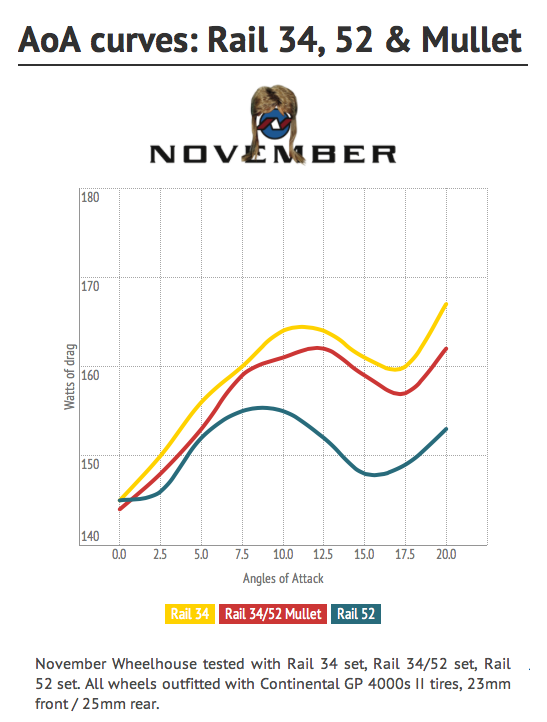 One of the tests we were most curious about was "the mullet." Our lovingly pejorative label for the 34 front/52 rear combo aside, we get asked about this all the time - "is the tradeoff worth it?" Despite having been accused of pulling the answer out of our rear by various internet eyeball aerodynamicists, we've actually put a bunch of study into it. VeloNews has covered it, and Zipp used to publish offset depth tests, so becoming informed was easy with some Google-fu. In the end you don't know until you test, so test we did.
One of the tests we were most curious about was "the mullet." Our lovingly pejorative label for the 34 front/52 rear combo aside, we get asked about this all the time - "is the tradeoff worth it?" Despite having been accused of pulling the answer out of our rear by various internet eyeball aerodynamicists, we've actually put a bunch of study into it. VeloNews has covered it, and Zipp used to publish offset depth tests, so becoming informed was easy with some Google-fu. In the end you don't know until you test, so test we did.
First we have to start off with a disclaimer. I move around too much on the bike to be used as a pedaling dummy. My mom would say "of course not - I didn't raise no dummy," but my active riding style meant that it was impossible to do the "rider on" portion of this test. More on this later, because it takes some special skill to be silent enough on a road bike to be a good dummy, and this has some ramifications.
Anyhow, to answer the mullet question, we ran three tests - 34s front and rear, 52s front and rear, and 34 front/52 rear. What we found was approximately precisely what we'd guessed - that the rear wheel accounts for less of the aerodynamics than the front. There's some "there" there, but the assumption that a wheel's benefit is the same front or rear is debunked. If they were equally important, the 34/52 set should have been a 50% closure of the gap to the 52/52 set from the 34/34 set. As it happened, it only crossed about a third of the gap.

The major motivation for people to do the offset set is to get the crosswind handling benefit of the shallower front with the aerodynamic benefit of the deeper rear. As it turns out, A2 is now able to quantify that as well, which will become part of the story soon. As sticky as it is to editorialize on data, everyone's still going to ask us if it's worth it, so having tested, our answer will be thus. If you want the shallower front in order to save weight, we've never seen a model where the sacrifice in aerodynamics would be worth the benefit in reduced weight. If you want all the aerodynamics you can get but are incontrovertibly certain that a 52mm deep wheel is too much to handle, then there is a bit of benefit to be gotten from the setup. As ever, my wording on the last sentence turns out to be quite meaningful.


7 comments
Dave,Loving those stories ;-) .I'm short on questions this time ;-))) , just one though : wheelsets are tested on a bike WITHOUT anybody on, right ? Light road bike (not aero) I guess since you don't make a TT ? Jack Mott,I've raced some very hilly triathlons with disc in the rear but switching to a 41mm in the front instead of 58mm or more in the front, I did not switch the front for weight saving but for technical descents, the bike really handle much much better in the corners and also in windy situation with the 41mm front wheel… so I don't necessarily agree deep/deep or disc/deep is more stable than deep/shallow.I sort of agree with you though where you are in the deep category for me disc rear/58mm front is not more stable than disc rear/81mm front, at least it is close enough that I don't really care. But disc/41mm is much easier to handle, I can almost ride hands free for a few seconds sometimes with that set, which I can't do with a deeper front.
Hi pyf – Yes, the tests were done on a November Wheelhouse, with no rider (as stated, I bounce around too much). No aerodynamic optimization at all was done to the frame/bike, save for removing my seat bag and Knog blinkie light. Pedals were removed, as is standard when testing sans rider.